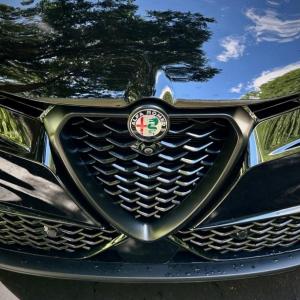Alfa Romeo Tonale Veloce EAWD
 This is the Tonale EAWD’s best feature—a sculpted prow adorned with Alfa Romeo’s hallowed badge, borrowed from the coat of arms of the House of Sforza, the hereditary dukes of Milan.
This is the Tonale EAWD’s best feature—a sculpted prow adorned with Alfa Romeo’s hallowed badge, borrowed from the coat of arms of the House of Sforza, the hereditary dukes of Milan.
 Alfa Romeo goes its own way with switches and controls—note the starter button on the left side of the steering wheel—but everything is driver-focused and easy to use.
Alfa Romeo goes its own way with switches and controls—note the starter button on the left side of the steering wheel—but everything is driver-focused and easy to use.
 The new-for-2024 Tonale is not unattractive, but only these optional 20-inch 5-hole wheels truly stand out.
The new-for-2024 Tonale is not unattractive, but only these optional 20-inch 5-hole wheels truly stand out.
 This is the Tonale EAWD’s best feature—a sculpted prow adorned with Alfa Romeo’s hallowed badge, borrowed from the coat of arms of the House of Sforza, the hereditary dukes of Milan.
This is the Tonale EAWD’s best feature—a sculpted prow adorned with Alfa Romeo’s hallowed badge, borrowed from the coat of arms of the House of Sforza, the hereditary dukes of Milan.
 Alfa Romeo goes its own way with switches and controls—note the starter button on the left side of the steering wheel—but everything is driver-focused and easy to use.
Alfa Romeo goes its own way with switches and controls—note the starter button on the left side of the steering wheel—but everything is driver-focused and easy to use.
 The new-for-2024 Tonale is not unattractive, but only these optional 20-inch 5-hole wheels truly stand out.
The new-for-2024 Tonale is not unattractive, but only these optional 20-inch 5-hole wheels truly stand out.
It’s another of those age-related disconnects that crop up more and more often: People in their 20s and 30s don’t know the Alfa brand. And a vanishingly small handful of them wonder why the name is Alfa and not Alpha, the first letter of the Greek (ahem) alphabet. Well, for starters, it’s not a Greek company; it’s Italian. Of course.
ALFA is an acronym for Anonima Lombarda Fabbrica Automobili, which means, oddly enough, Anonymous, or unknown, Fabricator of Automobiles in Lombardy. Lombardy is a far northern district of Italy, and ALFA was established in its capital, Milan, in 1910. ALFA began motor racing in 1911 and then, in 1915, in the first of many financial upheavals to come, it was taken over by a businessman named Nicola Romeo.
Nicola Romeo was from Naples, the capital of Campania, in far southern Italy. This may have caused a bit of a stir back then. It certainly caused a stir when, in the 1960s, Alfa Romeo production began to move to Campania. This had nothing to do with Signore Romeo’s roots. Rome—that is, Italy’s feds—leaned on Alfa Romeo to relocate production from the industrial North to create jobs in Italy’s rural South. Older northern Italians still fuss and fume that “Alfa Romeo hasn’t been the same since they started building cars down there.”
Alfa Romeo’s headquarters are still in the North, in Turin, because in 1986 it was acquired by the automaking giant Fiat (another acronym), which was founded in Turin in 1899. Fiat absorbed three other legendary Italian carmakers as well—Lancia, Maserati and Ferrari—and then scooped up Chrysler, Dodge and Jeep. Fiat itself is now part of a multinational conglomerate called Stellantis, which is based in Amsterdam and owns some 16 Italian, French and American automotive brands.
Almost lost now is the fact that Alfa Romeo became world-famous for its engines and a racing pedigree that today has been eclipsed by Porsche and Ferrari. So it’s no surprise that so many people, especially non-Europeans, no longer know Alfa Romeo. Unfortunately, the Tonale EAWD SUV isn’t going to change this sad state of affairs.
Here we have a legendary and historic Italian racing house offering us a two-row, urbanized sport-ute with a battery because it feels it has to do so in order to survive. Oh, but how difficult it is for a tiny company to compete in that niche with the likes of Toyota, Kia, Hyundai, Honda, Nissan, VW and all the rest—even, since Alfa Romeo also considers itself a luxury carmaker, BMW, Mercedes-Benz, Audi, Porsche, Volvo and Jaguar.
This is not to say the plug-in Tonale is a bad car. Up front there is a turbocharged 1.3-litre four-cylinder premium-gas engine; over the rear axle (and powering the rear wheels) is an electric motor powered by a 15.5 kWh battery pack and good for 30-some miles of errand-running before the gas engine awakens. Total system output is rated at 285 horsepower. The transmission is a 6-speed automatic with very large shifter paddles behind the steering wheel, and there are three drive modes.
So far, so good, although hardly outstanding. Still, it’s an Alfa! It must go like the clappers! Um, no. It doesn’t do that, either. Absent is the verve and vitality of bygone Alfas, or even modern Alfas such as the Giulia and Stelvio, especially the high-output Quadrifoglio versions. Like all battery-powered cars, it will squirt off the line with its electric torque, but then the party goes quiet. Top speed, response, handling, braking . . . nothing stands out, nothing shouts “I am an Alfa Romeo!”
Technology and luxury then? Nope. The same goes for the cabin and the safety and infotainment systems: all decent, if somewhat inscrutable, nothing ground-breaking or outstanding. Well, if the Tonale takes the safe middle ground, it must then compete on price, no?
No. the Tonale comes in three trim levels, all plug-in hybrids. The base Sprint starts at $42,995. The Ti starts at $46,655 and our sample Veloce (“fast”) begins at $46,695 and our sample stickers at an eye-opening $57,290. This thanks to such add-ons as heated and ventilated leather front seats, a 360-degree backup camera, parking assist, a power moonroof, 20-inch alloy wheels and a premium Harman-Kardon stereo.
Back to Alfa’s hallowed roots: The parents of Baby Boomers, the WWII veterans, and especially those with some European connections, revered Alfa Romeo above all others, even Ferrari and Lamborghini, for its stellar racing record and its sporting cars. To them, Enzo Ferrari was a so-so racing driver who got his start with Alfa Romeo and Ferruccio Lamborghini was a tractor manufacturer who couldn’t get what he wanted from Enzo Ferrari—Alfa-Romeo wannabes, that is to say. But times change.
Next week: Volvo V60 Cross Country


























